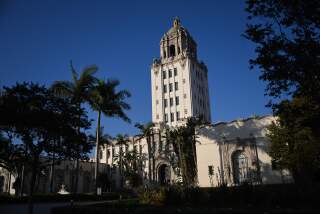Beverly Hills saddles up for centennial celebration
- Share via
In a quainter age, before Lamborghinis and Ferraris with big horsepower under the hood ripped along Rodeo Drive, the Beverly Hills thoroughfare featured … actual horsepower.
For four decades starting in 1924, riders in boots and jodhpurs clip-clopped on a bridle path that extended along the Rodeo median north of the city’s commercial zone to Sunset Boulevard and then on Sunset between the city’s eastern and western limits.
Early photos show equestrians ambling under a rustic wooden archway reading “Ye Bridle Path from Beverly Hills to Sea and Mountains.” The Beverly Hills Hotel, which employed a riding master and promoted the trail as a visitor amenity, often appears in the background.
On Sunday, Beverly Hills plans to commemorate Ye Bridle Path and other aspects of the city’s rancho-to-riches history with an equestrian parade and a preview of the city’s coming centennial year.
Known for Hollywood glamour, designer boutiques and the 90210 ZIP Code, Beverly Hills officially turns 100 on Jan. 28, and the city wants residents and tourists to have plenty of opportunities to mark the occasion.
“This is a chance to take stock, look at our history, celebrate the people who made the city and have fun together,” Mayor John Mirisch said.
The centennial year will kick off on New Year’s Day with a Rose Parade float celebrating the city’s “historical character and charm,” according to the city’s website.
On Jan. 28, the city will hold a birthday block party and a sing-along concert at the Saban Theatre featuring songs by the many composers who lived in Beverly Hills (among them Albert Von Tilzer, who wrote “Take Me Out to the Ball Game”).
Also in the works are art contests and shows, photo exhibits, a documentary, a book, a custom Beverly Hills rose and a film festival (in partnership with the Academy of Motion Picture Arts and Sciences) that will show movies set in Beverly Hills or with Beverly Hills in their titles.
City Hall, the Conference and Visitors Bureau, the Rodeo Drive Committee and the Chamber of Commerce have been involved in the planning. “We’ve all worked as a team,” said Richard Rosenzweig, a longtime resident and Playboy Enterprises executive who heads the centennial committee. Rosenzweig said the effort has attracted “150 enthusiastic volunteers.” He emphasized “enthusiastic,” suggesting that the volunteers have been full of ideas and opinions.
Today’s Beverly Hills would be unrecognizable to its founders. The area was once part of a 4,539-acre rancho held by Maria Rita Valdez. Valdez named the rancho Rodeo de las Aguas, or gathering of the waters, after the seasonal flow down Canyon of the Live Oaks (now Benedict Canyon).
Valdez sold the land in 1854, and the property subsequently changed hands many times. By the turn of the 20th century, the area contained hundreds of acres of open fields planted with cabbage and lima beans. A few families lived on small hillside ranches, while farmworkers stayed in shacks along the Red Car railroad tracks south of Santa Monica Boulevard.
In the early 1900s, an investment syndicate, later called Rodeo Land & Water Co., bought more than 3,000 acres and began carving it into lots. The developers had little luck attracting buyers until Henry Huntington, the railroad man, lured Margaret Anderson from her successful Hollywood Hotel to build and operate a posh destination in Beverly Hills.
The Beverly Hills Hotel opened in 1912 and offered an electric-trolley stop, riding stables, classes for children who spent the winter and Sunday worship. Fox hunts were held in the hills behind the hotel, amid bucolic open space now largely supplanted by mega-mansions. Celebrities and industry leaders who owned estates with stables used the system of trails, as did bedazzled hotel guests.
After the hotel opened, “the city took off,” said Robert S. “Robbie” Anderson, Margaret Anderson’s great-grandson and a local historian.
The new city was incorporated in 1914, and the founders named it after Beverly Farms, Mass.
By the early 1920s, the automobile had dramatically reduced demand for the trolley. The tracks along Sunset were removed, and Pacific Electric Co. gave up its leases to the former rail strip in 1923. About that time, Margaret Anderson’s son Stanley, the Beverly Hills Hotel manager, and Irving Hellman, a banker, organized the Bridle Path Assn. to promote installation of a “bridle path to the sea.”
Will Rogers, the cowboy humorist and polo player, joined local developers Max Whittier and Burton Green in backing the project.
The bridle path was popular with locals and visitors. But “as traffic increased so did the danger of mixing horses and cars,” said Robbie Anderson, who recalls riding his bicycle along the path in the 1950s.
After World War II, the Sunset portion was planted over. The rest of the path closed about 1965.
But on Sunday horses will be back in town. The Rodeo de los Caballos (gathering of the horses) parade along the 300 and 400 blocks of Rodeo Drive will include the Wells Fargo stagecoach, the Scripps Miramar Saddlebreds equestrian group, Fred Hayman (in his Giorgio Rolls-Royce) and the mayor of Beverly, Mass. The grand marshal will be Jennifer Rogers-Etcheverry, great-granddaughter of Will Rogers, Beverly Hills’ first mayor. She and her daughter, Meeghan, 22, will ride in a horse-drawn wagonette with members of the Will Rogers Polo Club.
“I’m very proud,” Rogers-Etcheverry said, “that they still think [Will Rogers] is an important part of their history.”
More to Read
Sign up for Essential California
The most important California stories and recommendations in your inbox every morning.
You may occasionally receive promotional content from the Los Angeles Times.











